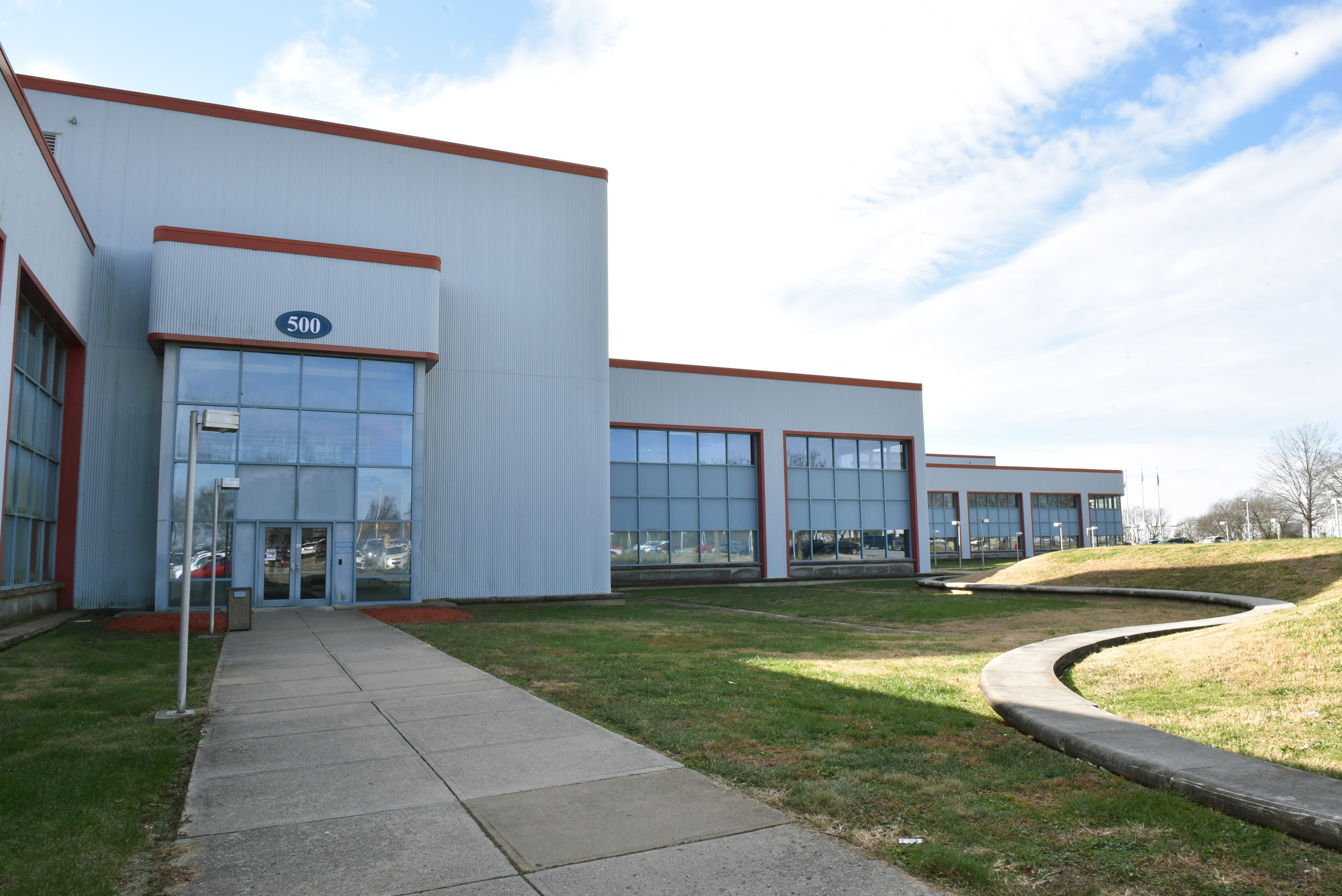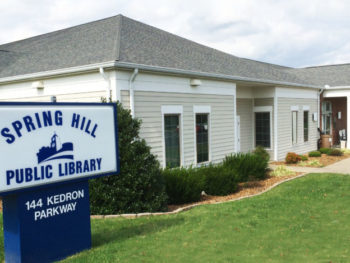In keeping with the City of Spring Hill’s expansion plans, the Building Codes & Inspections and Planning & Zoning Departments soon will be the first municipal departments to move from City Hall to the City-owned Northfield Building Complex.
The move, occurring the week of Dec. 26, will cause a brief disruption of service. If it’s possible for members of the public or developers needing planning, codes or development-related transactions to schedule any submittals you may have outside of the week of Dec. 26, please do so.
When these services have relocated from City Hall, 199 Town Center Parkway, to Northfield, 5000 Northfield Lane, here’s what you’ll need to know:
The Building Codes & Inspections and Planning & Zoning Departments will be located in Building 500.
- Public parking, including accessible parking spaces, is provided in front of Building 500.
- After entering Door 500, go up the stairs or elevator to the second floor where you’ll pass through the double doors. Enter the door on the right to our offices, Suite 520.
- All doors leading to these offices will be equipped with ADA-accessible, push-button door entry.
- Payment options: Cash, check and credit/debit card payments will be accepted at the Northfield offices.
- All City of Spring Hill-related Planning meetings (including the Staff Technical Review With Applicants Meeting, Pre-Application Meetings, and any other development-related appointments with the Planning and Codes Departments) will be held in the new Planning and Codes conference room within Suite 520, starting Jan. 1.
The two-story, 355,000-square-foot Northfield office building is roughly two miles southwest of City Hall, off Saturn Parkway and U.S. 31. The seven connected buildings on 38 acres served as the original Saturn Headquarters. The City purchased the building in December 2017 from the South Central Tennessee Workforce Alliance for $8.1 million with plans to renovate it over time to expand and relocate City services.
Construction is set to begin this winter on the renovation of Northfield Building 100 for the new, greatly expanded Spring Hill Public Library. Later in 2019, Building 700 will be renovated for the new Spring Hill Police Headquarters. Public Works and the GIS/IT Department are considering moving each of their operations into a portion of the building. Northfield also currently serves a wide range of lease tenants, including satellite locations of college and technical school programs, two call centers, the Spring Hill Chamber of Commerce, among other private offices, which brings in rental income that helps the City to offset the cost of owning and maintaining the building.
A BRIEF HISTORY OF NORTHFIELD
On July 30, 1985, Tennessee Gov. Lamar Alexander made the announcement that General Motors would build its new Saturn plant on 1,000 acres of farmland in Spring Hill. The $3.5 billion facility would bring 6,000 new jobs to Tennessee and begin a whole new story for the small farming town. The first Saturn in the world rolled off the line in Spring Hill in 1990. By 2006 the economy was beginning to change. Production of the Saturn brand at Spring Hill Manufacturing facility ended in 2007 and GM transitioned the plant into producing Chevrolet vehicles and parts. With the Saturn line gone and GM’s top brass already located in Detroit, they had no need to occupy the original Saturn headquarters building. They simply locked the doors. But the 355,000-square-foot dormant building still required 24-hour security. It’s estimated that there was a $1 million expense still on GM’s books every year related to the vacant building.
In June 2009, GM filed for Chapter 11 bankruptcy. Many GM plants had closed already but thankfully the Spring Hill plant had been only been idled down. They had to do something with the building now. They could not sell it because the plant’s infrastructure ran through the building. The cost to separate all of the services was not feasible either. Eventually they arrived at the decision to demolish the building. This would allow them to keep the infrastructure in tact but alleviate the expense line item associated with keeping the building up and they could recover some of the demolition cost by selling off the scrap steel.
A New Chapter
The South Central Tennessee Workforce Alliance has a mission to “serve the people of Giles, Hickman, Lawrence, Lewis, Marshall, Maury, Perry and Wayne Counties by acting as a catalyst for collaboration among job seekers, employers and workforce development partners. By developing a system through education, training and access to resources that improves opportunities for the successful linking of job seekers and employers, the Board will help to create economic opportunity for the region and the state.”
In the early 2000’s, SCTWA knew its eight-county region had a skills gap issue. The jobs were available but the labor pool was vastly unqualified for the needs of the companies. Maury County only had one available option for skills training at the time, Columbia State Community College, but even it still had a limited number of programs at the time. SCTWA partnered with Maury Alliance to strategize on a solution. Their collaboration produced a plan to form a new technical training facility where SCTWA could house a multitude of training courses adaptable to the demand of the employers. GM and the UAW labor union were so supportive of the plan that they agreed to release the manager of their apprenticeship-training program, Rick Sikes, to run the training facility fulltime for one year and still pay him his regular salary. They had a plan and someone to run it; now all they needed was money and a building. They started looking for a spec building but there was nothing available. They pressed on seeking avenues for acquiring funds to build, but that wasn’t working out either. Every way they turned they hit another wall.
Meanwhile newly elected State Representative Ty Cobb, a Maury County resident, had started working with the SCTWA team on the training facility idea. He had heard about the intent to demolish the old headquarters building, also known as “Northfield.” Representative Cobb immediately suggested they try to convince GM to abort tearing down the building and let them obtain it for the new training facility. Everyone was immediately on board and began discussions with the head of GM real estate, Holly Malewski. Representative Cobb went to Governor Phil Bredesen and pitched the idea in hopes of gaining his help with the financial side. Gov. Bredesen liked the plan and committed a $5 million grant through the State ECD to establish a workforce development center at Northfield. While this was a huge success, $5 million would be really only enough to get them started. They would be able to separate the building from GM, purchase it, build a new road to access it, and get instructors in the building. The financial plan would be incredibly difficult but everyone, especially Mrs. Malewski, worked tirelessly to successfully draft and execute a very technical lease purchase agreement that had never been done before. GM also decided to include an adjacent 3-acre piece of property with a building on it that had been a Bank of America branch for the plant, but was also unoccupied.
The Workforce Alliance, led by Executive Director Jan McKeel, moved into the building in 2009 and, by the time they purchased the building in 2014, they had the functioning workforce development training center they had been striving for. They sold off the bank building, which allowed them to create leasable conference center spaces and office spaces. The revenue generated by those spaces allowed the schools to have their space in Northfield rent-free. That particular piece was very important to SCTWA. They wanted those providing the education to use their budgets to develop programs the workers needed, not pay for overhead.
Shortly after SCTWA’s purchase of the building, the money from the state grant ran out. SCTWA would have to start charging rent to the schools but only charged them enough to cover the cost of utilities and common area maintenance. Most of them were able to pay since it was such a small amount but there were some that could not, or would not. For a time SCTWA was able to keep it all going but the writing was on the wall. If they did not find more tenants soon, they were headed for dire straits.
Opportunity For Redevelopment
In October 2017, South Central Tennessee Workforce Alliance decided it was time to sell Northfield. Their efforts to increase tenancy had been unsuccessful and the executive director had announced her intent to semi-retire. They notified the local economic developer of their intent to list the 355,000-square-foot building and the 32 acres it sits on for $12 million. The property needed a lot of work but it would be an amazing redevelopment project. It would also be a good opportunity for a TIF program as it is located adjacent to a major interstate and surrounded by growing developments.
The City of Spring Hill’s Economic Development Office realized that while this could become an active project for a few different business prospects looking in the area, it also meant the City would be losing its workforce development center. A private sector buyer/redeveloper would never be able to allow the education providers to stay there for the almost non-existent rent they were paying at the time and none of them would be able to afford a price increase of any kind. They would have to shut down their satellite programs. Having a local workforce development facility is a valuable asset to any community actively recruiting business. It is also incredibly beneficial to the existing industries. SCTWA had customized the education around the regional employers’ needs right in their own back yard. Those businesses would lose a huge asset to their model and the region could wind up losing them if they are not able to find qualified candidates.
The EDO came up with a plan to accomplish both. Instead of spending $23 million dollars, the estimated cost to build 53,000 square feet of space for the City’s new library and police department, the recommendation was made to purchase the 355,000-square-foot building for $12 million as a redevelopment project for a new municipal campus encompassing all of the City’s existing and future services.
The City of Spring Hill’s long-time desire to streamline services could finally be achieved by turning the Northfield Building into a full municipal campus for all City services. When the offices that the public need to access are all located in the same building, it is more convenient and less confusing. Even if someone happens to wind up in the wrong office, they can be easily redirected down a different hallway instead of having to get back in their car and travel across town. There is a general assumption by citizens that “everything is at City Hall.” Many are frustrated when they arrive to find that is not the case. Relocating all of our City services to one building eliminates the confusion of where to go when they need something from their government.
Since the City’s purchase of the building, we have seen a significant increase in calls about leasing space and now have two new tenants. The EDO has landed a new corporate relocation in the old bank building, the Union Sportsmen’s Alliance, which opened in November. A domino effect of benefits has begun and the excitement is growing. The City is proud to be the new caretakers of this building that had such a significant role in its history. Everything has come full circle. Saturn came to Spring Hill in 1990 and started a new life for the then small town. Now, almost 30 years later, that same site will become the actual heart of this up-and-coming city.




